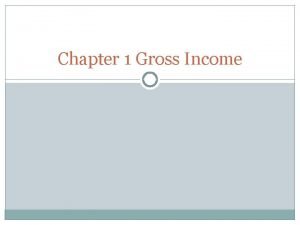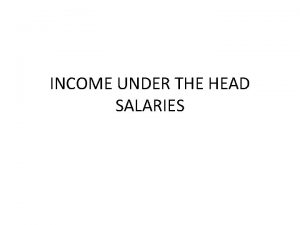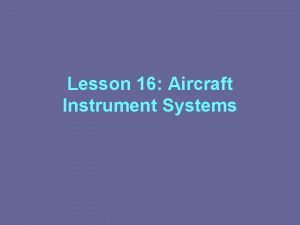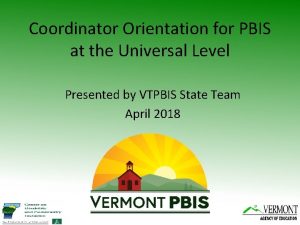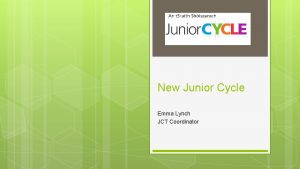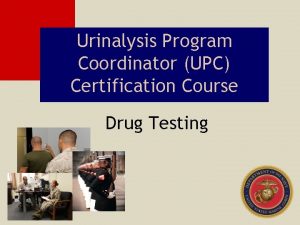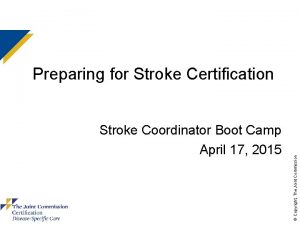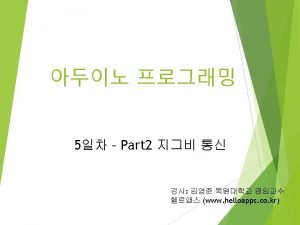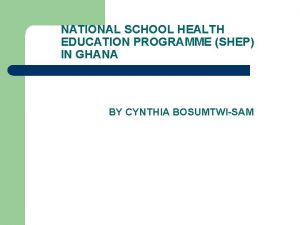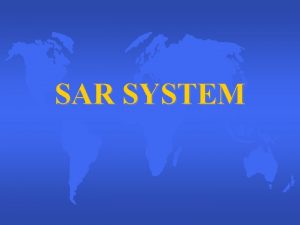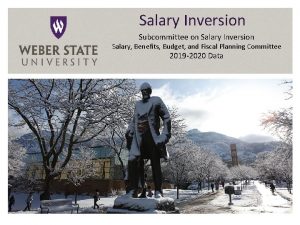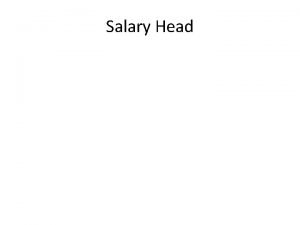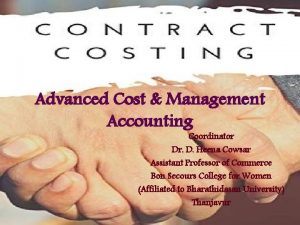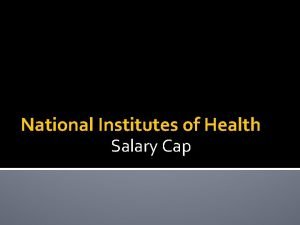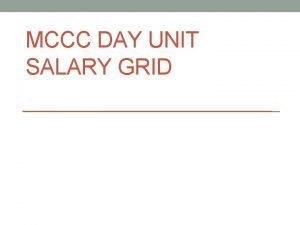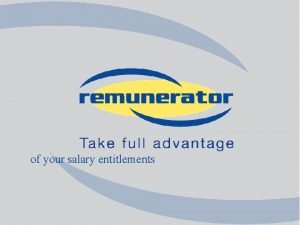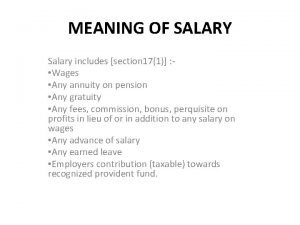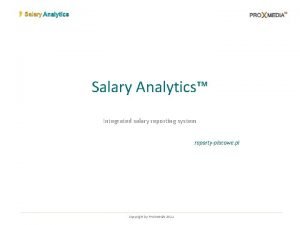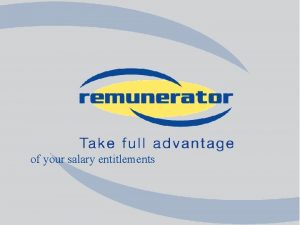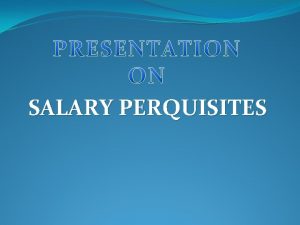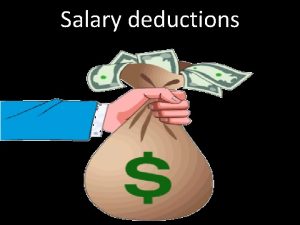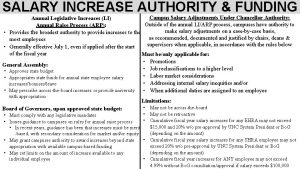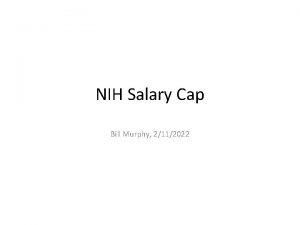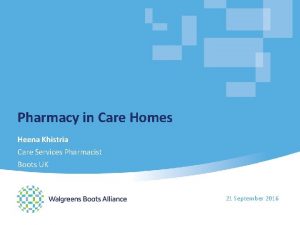Income from Salary Coordinator Dr D Heena Cowsar




















- Slides: 20

Income from Salary Coordinator Dr. D. Heena Cowsar Assistant professor of Commerce Bon Secours College for Women, Thanjavur Affiliated to Bharathidasan University

Slide 1: Introduction Tax is charged on the total income of an Assessee as per income tax act of 1961. Under Sec 5 basis for computation of total income is charged. Salary income of an employee is to be computed in accordance with the provisions laid down in sections 15, 16 and 17.

Slide 2: How salary is defined The term salary includes • Wages • Any Annuity or Pension • Any Gratuity • Any fees, Commission, Perquisites or profit in lieu of Salary or in addition to salary • Any Advance salary • Any payment received by an employee in respect leave not availed by him during service. • The total sum accredited to the credit of the employee recognised Provident fund to the extent chargeable to tax • Transferred balance in a recognised Provident fund to the extent it is chargeable • Amount credited by the central Government or any employer to the employee under notified pension schemes as mentioned in 80 CCD

Slide 4: Format to compute Salary

Slide 5: Allowances Fully Taxable allowances • Dearness Allowance: The allowance is paid to the employees to cope with inflation. • Entertainment Allowance: This is an allowance that is provided to the employees to reimburse the expenses which are incurred on the hospitality. • Overtime Allowance: Overtime allowance is the allowance which is paid to the employees for working above the regular work hours. • City Compensatory Allowance: This allowance is paid to those employees who move to urban cities. • Project Allowance: When an employer provides an allowance to the employees to meet the project expenses. • Tiffin/Meals Allowance: Employees may be provided with meal allowances in some cases. • Cash Allowance: Employer may also provide cash allowance in some cases like for marriage or holiday purposes.

Slide 6: Partly Taxable allowances • House Rent Allowance: It is the allowance that an employer pays to his employee for accommodation. • Entertainment allowance • Special allowances like allowance for travel, uniform, research allowance etc. • Special allowance to meet personal expenses like children’s education allowance, children hostel allowance etc.

Slide 7: Non Taxable allowances • Allowances that is paid to the Govt. servants abroad: When the government employee of India are paid allowances when they are serving abroad. • Sumptuary allowances: Sumptuary allowances which are paid to the judges of HC and SC are not taxed. • Allowance paid by UNO: Allowances which is received by the employees of UNO are fully exempt from tax. • Compensatory allowance paid to judges: When a judge receives a compensatory allowance, it is also not taxable.

Slide 8: Perquisites are those payments which are received by an employee from the employer over and above the salary. Perquisites that are taxable for all the employees: • Rent free accommodation • Club fee payments • Movable assets • Concession in accommodation rent • Interest-free loans • Educational expenses • Insurance premium paid on behalf of employees

Slide 9: Perquisites that are taxable only to specified employees • Free gas, electricity etc. for domestic purpose • Concessional transport facility • Concessional educational expenses • Payment made to gardener, sweeper and attendant. Perquisites that are exempt from tax • Medical benefits • Health Insurance Premium • Leave travel concession • Staff Welfare Scheme • Car, laptop etc. for personal use

Slide 11: House Rent Allowance (HRA) Meaning: The employer does not provide rent- free accommodation, but instead makes a provision to pay some amount in cash, so that the employee may be compensated to some extent as far as rent is concerned. The amount of cash paid is known as House Rent Allowance. Out of the total H. R. A. received, an amount equal to the minimum of the following three items is exempted from tax u/s 10(13 A). Taxable/ Exempted HRA Taxable HRA Least of the following are the Exempted HRA Actual HRA received xxx Actual HRA xxx Less: Exempted amount of HRA xxx Rent Paid- 10% of salary* xxx Taxable HRA xxx 40% or 50% of Salary** xxx Which ever less is exempted Xxx Note: *Salary= Basic Pay + DA (forming part)+ Fixed Percentage of Commission ** 50% of Salary for Delhi, Mumbai, Kolkatta and Chennai and 40% in others

Slide 12: Entertainment Allowances • It is an amount paid to the employees for the purpose of hospitality of the customers. • Government employees can claim tax exemption for the entertainment allowance under section 16 (ii) This deduction is allowed only to a Government employee. • Non-Government employees shall not be eligible for any deduction on account of any entertainment allowance received by them. • In case of entertainment allowance, an Assessee is not entitled to any exemption but he is entitled to a deduction under section 16(ii) from gross salary. • Therefore, the entire entertainment allowance received by any employee is added in computation of the gross salary. • The Government employee is, then, entitled to deduction from gross salary under section 16(ii) on account of such entertainment allowance to the extent of minimum of the following 3 limits. For Government Employee For Non Government Employee Actual entertainment allowance received during xxx the previous year. • No Deductions U/S 16(II) • Full Gross amount is taxable 20% of his salary exclusive of any allowance, benefit or other perquisite. xxx Absolute limit Rs. 5000 Which ever less is exempted Note: Only Basic Salary pay is to be considered xxx

Slide 13: Gratuity Sec 10(10) Gratuity is a payment made by the employer to an employee in appreciation of the past services rendered by the employee. Gratuity can either be received by: (a) the employee himself at the time of his retirement; or (b)the legal heir on the event of the death of the employee. Gratuity received by an employee on his retirement is taxable under the head "Salary" whereas gratuity received by the legal heir of the deceased employee shall be taxable under the head "Income from other sources". However, in both the above cases, according to section 10(10) gratuity is exempt up to a certain limit. Therefore, in case gratuity is received by employee, salary would include only that part of the gratuity which is not exempt under section 10(10) is discussed in the Table • • Government employees & employees of local authority Non Government Employees: Least of the following Exempted Employees covered under Gratuity Actual Gratuity received Absolute limit (Rs. ) Fully Exempt Note: 1. Salary 2. xxx 1000000 Employees not covered under Gratuity Actual Gratuity received Absolute limit (Rs. ) xxx 1000000 15 days salary *for every year of completed services xxx ½ Months Average Salary* for every year of completed service xxx Which ever less is exempted Xxx Last Month Salary (Basic+ DA+ % of Commission) *Average Salary: Last 10 Months Salary (Basic+ *15 Days = Consider 15/26 DA (FP)+ % of Commission)

Slide 14: Pension (Sec 17 (1)(ii) • • • Pension is a payment made by the employer after the retirement/death of the employee as a reward for past service. Pension is normally paid as a periodical payment on monthly basis but certain employers may also allow an employee to forgo a portion of the pension and receive a lump sum amount by surrendering such portion of pension. This is known as commutation of pension. The pension may be fully or partly commuted i. e. in lieu of the pension, a lump sum payment is made to the employee. Uncommuted pension i. e. the periodical pension: It is fully taxable to both government or non-government. Exemption of Commuted Pension U/s 10(10 A) Employee Status Gratuity Received / Not Received Exemptions related to Commuted Pension Government Employee Gratuity may received or may not received Fully Exempted Gratuity Received 1/3 of the Full pension* is Exempted Gratuity not received 1/2 of the Full pension* is Exempted Non Government Employee Full Pension = Commuted + Uncommuted Pension.

Slide 15: Leave Encashment • • • Under employment, generally, an employee is granted casual leaves, medical leaves and privileged leaves or earned leaves. He can accumulates his medical leaves and privileged leaves and can avail such leaves in subsequent years. An employee can even encash his accumulated privileged/earned leaves and can get salary for the said period of leave. Such receipt of salary by an employee from his employer in lieu of his accumulated leaves is called “Leave Encashment”. Such encashment can be done by an employee either during the service or at the time of leaving job due to retirement or any other reason. However, in case of death of an employee, the salary for his/her accumulated leave is given to his/her legal heirs.

Slide 16 : How to calculate exemptions for leave Salary For Government Employees For Non Government Employees (including Local authority & Public Sector Undertakings) Actual leave Salary Received xxx 10 months Average Salary xxx Absolute Limit (Rs. ) Fully Exempted Salary* for unutilized eligible leave (consider 30 days per year)** Which ever less is exempted 300000 xxx *Salary = Average Salary ** If the company gives less than 30 days then that should be considered

Slide 17: Provident Fund (PF) • • • It is a scheme where employee contributes some part of money from his salary as savings in form of Provident fund. Similarly the employer will also contributes the corresponding the same amount towards employees Provident fund. The interest earned out of this contribution is also credited to his account Employee can also obtain loan from the PF account. The accumulated some of money will be paid at the time of retirement Types of Provident fund – 1. Statutory Provident Fund 2. Recognised Provident Fund – 3. Unrecognised Provident Fund 4. Public Provident Fund Statutory PF: § it is formed to promote saving habit among Recognised PF Unrecognised PF: Public PF government employees, §It is followed by Government, Semi government, railways, Local authorities, Insurance companies etc §It is not recognised by the commissioner of Income. Tax. §Both the employer & Employee contribute §It is fund maintained by industrial undertakings & Banks §Both the employer & Employee contribute §The other 3 types of Provident fund are for salaried people, this for promoting saving habit of not salaried employees §This is for self employed people like doctor, lawyers, accountants, professionals etc.

Slide 18: Tax treatment of Provident fund Sl. No 1 2 3 4 Particulars SPF RPF URPF Employees Contribution Fully Deducted U/s 80 C Deduction U/s 80 C is not applicable Fully Deducted U/s 80 C Employers Contribution Fully exempted Employers contribution over 12% of employees salary is Taxable Not Taxable No contribution by the employer Interest Fully exempted Interest over 9. 5% is taxable Not Taxable Lump sum amount received on Retirement Not Taxable Exempted * • Employees Contribution. Not taxable • Interest on Employees Contribution- Other sources • Employers Contribution & Interest on it – Taxable under Salary. Not Taxable * Exempted to those employees who saves for a period of 5 years or more PPF

Slide 19: Deductions U/s 16 The income chargeable under the head “Salaries” is computed after making the following deductions under Section 16. It comprises of 3 deductions ØStandard Deduction ; ØEntertainment Allowance Deduction ; and ØProfessional Tax. Standard Deduction [Sec. 16(i)/(ia)] - Standard deduction is Rs. 40, 000 ; or the Amount of Salary, whichever is Lower. Entertainment Allowance Deduction For Government Employee Actual entertainment allowance received during the previous year. xxx 20% of his salary exclusive of any allowance, benefit or other perquisite. xxx Absolute limit (Rs. ) Which ever less is exempted • For Non Government Employee 5000 • No Deductions U/S 16(II) • Full Gross amount is taxable xxx Professional Tax- Professional Tax or Tax on Employment, levied by a State under article 276 of the Constitution, is Allowed as Deduction. ØDeduction is available only in the year in which professional tax is paid. ØIf the professional tax is paid by the employer on behalf of an employee, it is first included in the salary of the employee as a “perquisite” and then the same amount is allowed as deduction on account of “professional tax” from gross salary. ØThere is no monetary ceiling under the Income-tax Act. Under article 276 of the Constitution, a State Government cannot impose more than Rs. 2, 500 per annum as professional tax. Under the Income-tax Act, whatever professional tax is paid during the previous year, is deductible.

Slide 20: Deduction u/s 80 C Amount saved and deposited by the employee or Assessee in following savings schemes shall qualify for deduction u/s 80 C. Sl. No Particulars Amount 1 Amount deposited by the employee in SPF xxx 2 Amount deposited by the employee in RPF xxx 3 Amount deposited by the employee in PPF xxx 4 Payment of Life Insurance Premium • 20% of capital sum assured if policy is issued before 1 -4 -2012 • 10% of capital sum assured if policy is issued during 2012 -13 • 15% of capital sum assured if policy is issued on or after 1 -4 -2013 xxx xxx 5 Contribution towards non commuted deferred annuity xxx 6 Deposits made in Unit Linked Insurance Plan (ULIP) xxx 7 Amount invested in National Savings Certificates—VIl. I Issue or IX issue. xxx 8 Amount paid to LIC under Jeevan Dhara, Jeevan Akshay Policies. xxx 9 Amount deposited with National Housing Bank xxx 10 Amount deposited with an authority engaged in Housing Development or Town or Rural Development. xxx 11 Amount deposited or invested in Equity Linked Saving Scheme (ELSS) xxx 12 Repayment of house building loan. xxx 13 Payment of Tuition fees. xxx 14 Amount paid as subscription to equity shares or debentures. xxx 15 Amount paid as subscription to units of a mutual fund. xxx

 Dr heena contractor
Dr heena contractor Straight time pay worksheets
Straight time pay worksheets Salary meaning
Salary meaning Tax payable
Tax payable Statement of equity meaning
Statement of equity meaning Calculate income tax
Calculate income tax Personal income formula in national income
Personal income formula in national income Ssvf university webinars
Ssvf university webinars How does a turn coordinator work
How does a turn coordinator work Level coordinator
Level coordinator Jct coordinator role
Jct coordinator role Upc certification
Upc certification Stroke coordinator boot camp
Stroke coordinator boot camp Title 1 coordinator lausd
Title 1 coordinator lausd White coordinator step
White coordinator step Xctu coordinator
Xctu coordinator Ken nathens lawyer toronto
Ken nathens lawyer toronto School wins coordinator duties and responsibilities
School wins coordinator duties and responsibilities Responsibilities of class coordinator in college
Responsibilities of class coordinator in college Shep
Shep Define uu
Define uu

